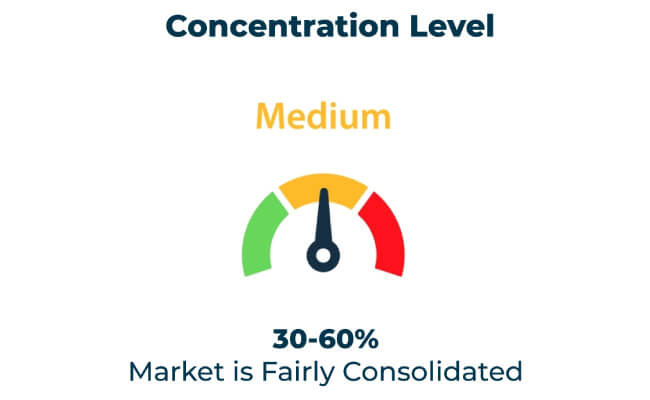The disposable food container market is growth-oriented, driven by the fast-growing demand for sustainable and innovative packaging.
The key growth drivers of such a market will be leading players like Huhtamaki, Dart Container, and WestRock with their versatile eco-friendly food container solutions for applications in food service and retail sectors. The market will grow at 5.1% CAGR and will reach USD 32.26 billion in 2035. The increase in consumer awareness regarding sustainability and the requirement of lightweight, recyclable packaging gives a momentum to the growth.
| Attribute | Details |
|---|---|
| Projected Value by 2035 | USD 32.26 billion |
| CAGR during the period 2025 to 2035 | 5.1% |
Global Market Share & Industry Share (%)
| Category | Market Share (%) |
|---|---|
| Top 3 Players (Huhtamaki, Dart, WestRock) | 15% |
| Rest of Top 5 Players | 10% |
| Next 5 of Top 10 Players | 9% |
Type of Player & Industry Share (%) 2025
| Player Tier | Industry Share (%) |
|---|---|
| Top 10 Players | 34% |
| Next 20 Players | 65% |
| Remaining Players | 1% |

Year-over-Year Leaders
The disposable food container market aligns closely with global sustainability objectives through the use of recycled and biodegradable packaging solutions.
The growing global demand for lightweight, eco-friendly packaging solutions presents significant export opportunities for disposable food container manufacturers. Key growth regions include Asia-Pacific, Africa, and Latin America.
The disposable food container market will continue to grow as industries prioritize sustainability and lightweight packaging. Companies investing in innovative materials and processes will shape the future of this dynamic sector.
| Tier | Key Companies |
|---|---|
| Tier 1 | Huhtamaki, Dart Container, WestRock |
| Tier 2 | Mondi, Sabert Corporation |
| Tier 3 | Genpak, Biopak |
Disposable food containers will continue to gain growth momentum in a market that places high value on sustainability and convenience. Those who invest in advanced technologies and green practices will shape the industry's future.
Key Definitions and Terminology:
Research Methodology
Market Definition
The disposable food container market is expected to have a CAGR of 5.1% for the period 2035.
The market is expected to achieve a value of USD 32.26billion by 2035.
The top 10 players hold around 34% of the market share globally.
The key manufacturers include Huhtamaki, Dart Container, and WestRock.






Our Research Products

The "Full Research Suite" delivers actionable market intel, deep dives on markets or technologies, so clients act faster, cut risk, and unlock growth.

The Leaderboard benchmarks and ranks top vendors, classifying them as Established Leaders, Leading Challengers, or Disruptors & Challengers.

Locates where complements amplify value and substitutes erode it, forecasting net impact by horizon

We deliver granular, decision-grade intel: market sizing, 5-year forecasts, pricing, adoption, usage, revenue, and operational KPIs—plus competitor tracking, regulation, and value chains—across 60 countries broadly.

Spot the shifts before they hit your P&L. We track inflection points, adoption curves, pricing moves, and ecosystem plays to show where demand is heading, why it is changing, and what to do next across high-growth markets and disruptive tech

Real-time reads of user behavior. We track shifting priorities, perceptions of today’s and next-gen services, and provider experience, then pace how fast tech moves from trial to adoption, blending buyer, consumer, and channel inputs with social signals (#WhySwitch, #UX).

Partner with our analyst team to build a custom report designed around your business priorities. From analysing market trends to assessing competitors or crafting bespoke datasets, we tailor insights to your needs.
Supplier Intelligence
Discovery & Profiling
Capacity & Footprint
Performance & Risk
Compliance & Governance
Commercial Readiness
Who Supplies Whom
Scorecards & Shortlists
Playbooks & Docs
Category Intelligence
Definition & Scope
Demand & Use Cases
Cost Drivers
Market Structure
Supply Chain Map
Trade & Policy
Operating Norms
Deliverables
Buyer Intelligence
Account Basics
Spend & Scope
Procurement Model
Vendor Requirements
Terms & Policies
Entry Strategy
Pain Points & Triggers
Outputs
Pricing Analysis
Benchmarks
Trends
Should-Cost
Indexation
Landed Cost
Commercial Terms
Deliverables
Brand Analysis
Positioning & Value Prop
Share & Presence
Customer Evidence
Go-to-Market
Digital & Reputation
Compliance & Trust
KPIs & Gaps
Outputs
Full Research Suite comprises of:
Market outlook & trends analysis
Interviews & case studies
Strategic recommendations
Vendor profiles & capabilities analysis
5-year forecasts
8 regions and 60+ country-level data splits
Market segment data splits
12 months of continuous data updates
DELIVERED AS:
PDF EXCEL ONLINE
Disposable Food Containers Market Size and Share Forecast Outlook 2025 to 2035
Breaking Down Market Share in Rigid Food Containers
Europe Foodservice Disposables Market Insights – Growth & Trends 2024-2034
Foodservice Disposable Market Growth & Trends Forecast 2024-2034
Food Storage Container Market Size and Share Forecast Outlook 2025 to 2035
Foam Food Container Market Size and Share Forecast Outlook 2025 to 2035
Fast Food Containers Market Trends – Growth & Forecast 2025 to 2035
Deli Food Container Market Trends & Industry Growth Forecast 2024-2034
Rigid Food Containers Market Size and Share Forecast Outlook 2025 to 2035
Hinge Food Container Market Analysis - Size, Share, and Forecast Outlook 2025 to 2035
Key Companies & Market Share in the Food Trays Sector
Disposable Specimen Container Market
Analyzing Food Emulsifier Market Share & Growth Trends
Analyzing Container Liner Market Share & Industry Leaders
Competitive Breakdown of Disposable Cups Providers
Evaluating Food Stabilizers Market Share & Provider Insights
Market Share Breakdown of Disposable Plates Providers
Industry Share & Competitive Positioning in Food Portion Pack
Insulated Food Containers Market
Market Share Insights in the Frozen Food Industry

Thank you!
You will receive an email from our Business Development Manager. Please be sure to check your SPAM/JUNK folder too.
Chat With
MaRIA